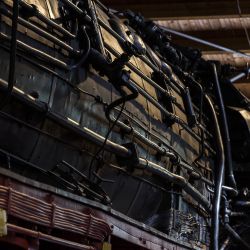
Download this article:
The German Museum of Technology (Deutsches Technikmuseum) is one of the largest museums of its type in Germany. ERCO recently upgraded the lighting to LED technology. The project demonstrates how improvements in efficiency and the optimisation of light go hand-in-hand.
With around 600,000 visitors annually, the German Museum of Technology in Berlin is a genuine crowd-puller in the German capital city's multifaceted museum landscape. The museum with both permanent and special exhibitions and space of around 26,000 square metres exhibits a wide spectrum of themes ranging from aviation and shipping to rail and road traffic and far beyond.
Energy savings as the motivating factor
The relighting of the museum was primarily motivated by the desire to achieve an improved energy balance, stated Professor Joseph Hoppe, Deputy Director of the museum. Awarding the contract to ERCO through a tender procedure was carried out on the basis of a consumption analysis and sampling. Besides energy efficiency and brilliance of light, ERCO also scored points with the durability and reliability of their products.
A qualitative quantum leap in museum lighting
The museum relighting, technically supervised by the lighting designer Karsten Krause, gained favourable reactions both internally and from the public. The savings are impressive: by converting to LED technology the museum is able to save annual energy costs of 125,000 euros. This corresponds to a reduction of CO2 emission of 395 tonnes. Museum manager Hoppe sees a further aspect as being just as important - the quantum leap in quality with the museum lighting. "The new light allows both us and the public to discover things we never saw before." Hoppe praised the ERCO Spherolit lenses and the corresponding variability and flexibility of the luminaires: the easily exchanged lenses mean that the museum team can also fine-tune and readjust the light at a later date.
The photometric challenge
No room resembles another in the German Museum of Technology, either in relation to the architecture and daylight situation or regarding the items on display and the exhibition design. The objects themselves differ enormously in terms of size, materials and surfaces, with some suspended in the space and others displayed in cabinets. Despite the extremely diverse lighting requirements as a result of this, only three ERCO luminaire families with power consumption of between 4 and 48 watts are needed for the lighting tasks: Optec, Parscan and Pollux. Optec spotlights with 12 and 24 wattages and narrow spot, spot, flood, wide flood and oval flood light distributions provide the high-performance basis of the museum lighting. Parscan with 48 watts are used in high rooms where light needs to be projected over long distances, while Pollux contour spotlights emit precise light onto pictures, information signs and text panels.
With its relighting the German Museum of Technology in Berlin sets standards for contemporary museum lighting that will remain in use for many years. ERCO once again demonstrates its expertise in a photometrically highly challenging area. The project also illustrates the variable and diverse application options of ERCO lighting tools.
Project data
Project: German Museum of Technology, Berlin / Germany
Lighting design: Karsten Krause, Berlin / Germany
Photography: Dirk Vogel, Dortmund / Germany
Products: Optec, Parscan, Pollux
Photo credits: © ERCO GmbH, www.erco.com, photography: Dirk Vogel
About ERCO
The ERCO Light Factory in Lüdenscheid is a leading international specialist in architectural lighting using LED technology. The family business, founded in 1934, now operates as a global player with over 60 subsidiaries, branches and agencies in over 40 countries worldwide. Since 2015 ERCO's portfolio has been 100% LED. Inspired by "light digital" as its leitmotif, ERCO in Lüdenscheid develops, designs and produces digital luminaires with focus on photometrics, electronics and design. Working closely with architects, lighting designers and engineers, ERCO develops lighting tools used primarily for applications in the following fields: Work, Shop, Culture, Community, Hospitality, Living, Public and Contemplation. ERCO understands digital light as the fourth dimension of architecture - providing highly precise and efficient lighting solutions to support creative designers in turning their visions into reality.
If you require any further information on ERCO or image material, please visit us at www.erco.com/presse. We can also provide you with material on projects worldwide for your media coverage.
Relevant image material
© ERCO GmbH, www.erco.com
© ERCO GmbH, www.erco.com
© ERCO GmbH, www.erco.com
© ERCO GmbH, www.erco.com
© ERCO GmbH, www.erco.com
© ERCO GmbH, www.erco.com
© ERCO GmbH, www.erco.com
© ERCO GmbH, www.erco.com
© ERCO GmbH, www.erco.com
© ERCO GmbH, www.erco.com









